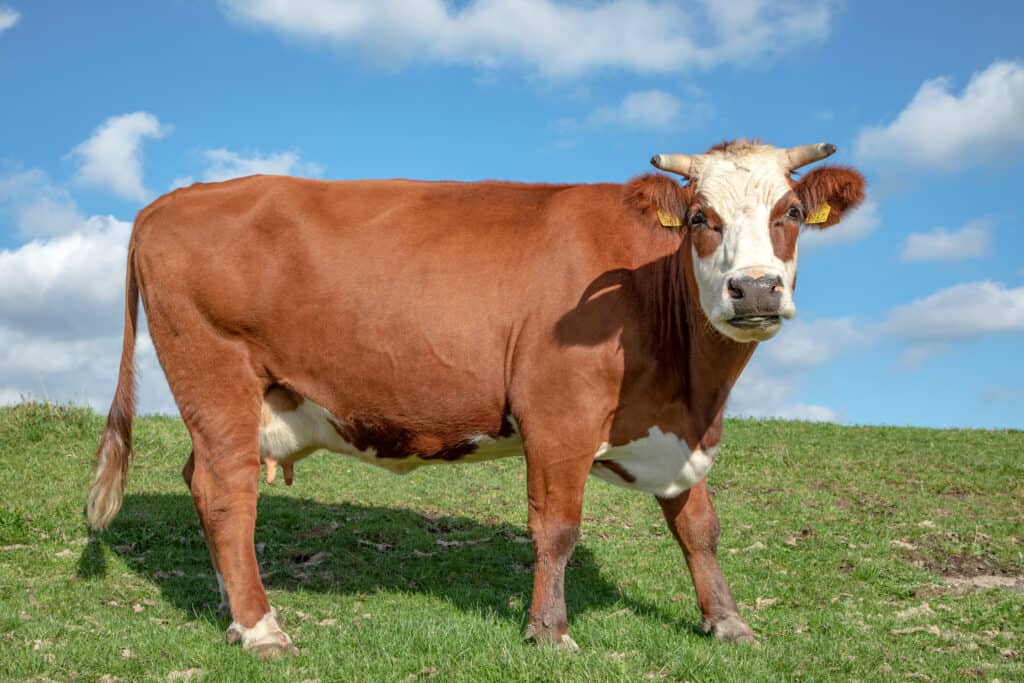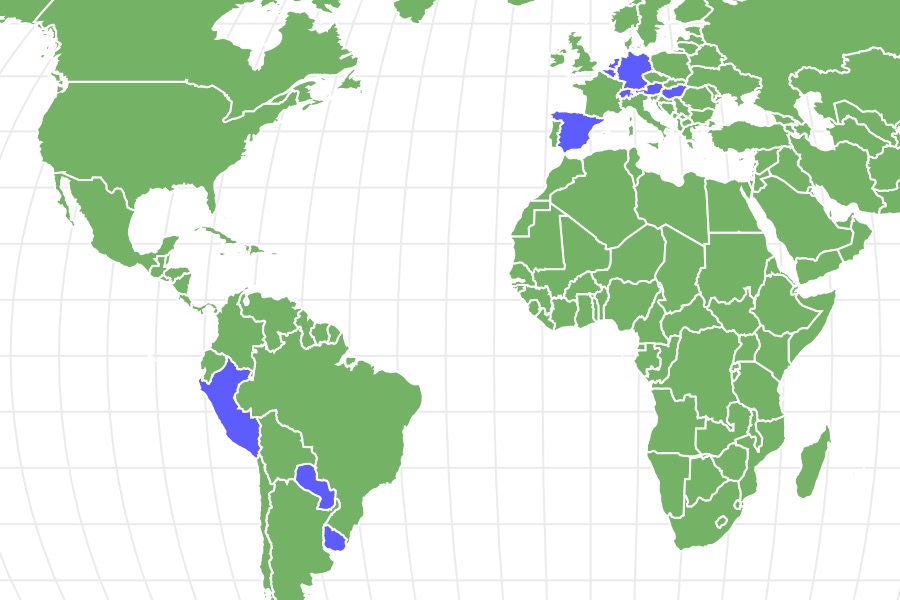Fleckvieh Cattle
Bos taurus taurus
Besides being bred for milk and meat, these cattle were also used as draft oxen.
Advertisement
Fleckvieh Cattle Scientific Classification
- Kingdom
- Animalia
- Phylum
- Chordata
- Class
- Mammalia
- Order
- Artiodactyla
- Family
- Bovidae
- Genus
- Bos
- Scientific Name
- Bos taurus taurus
Read our Complete Guide to Classification of Animals.
Fleckvieh Cattle Conservation Status
Fleckvieh Cattle Facts
- Name Of Young
- Calf
- Group Behavior
- Herd
- Fun Fact
- Besides being bred for milk and meat, these cattle were also used as draft oxen.
- Estimated Population Size
- 41 million
- Most Distinctive Feature
- Red coloring with a white face
- Distinctive Feature
- Size
- Other Name(s)
- Simmental cattle
- Gestation Period
- 9 months
- Age Of Independence
- 5 to 6 months
- Litter Size
- 1
- Habitat
- Open plains
- Predators
- Coyotes, Cougars, Bobcats, Lynx, Wolves, Bears, Black-backed jackals, Caracals, Leopards, Cheetahs, Brown Hyenas
- Diet
- Herbivore
- Lifestyle
- Diurnal
- Herd
- Favorite Food
- Grass-sourced forage
- Common Name
- Fleckvieh cattle
- Origin
- Austria
- Location
- Hungary, Switzerland, Spain, Netherlands, Germany, Belgium, Austria, Peru, Uruguay, Paraguay
Fleckvieh Cattle Physical Characteristics
- Color
- Red
- White
- Lifespan
- 6 years
- Weight
- 1.2 to 1.4 tons
- Height
- 4.5b to 5.5 feet
- Age of Sexual Maturity
- 8 to 10 months
- Age of Weaning
- 5 to 6 months
- Aggression
- Low
View all of the Fleckvieh Cattle images!
Fleckvieh cattle serve a dual purpose and are raised for their meat and milk production. They became popular in the 19th century and originated in Austria, but now can be found all across Europe, the USA, and certain parts of South America.
These cattle result from cross-breeding native stock with Simmental cattle native to Switzerland around the 1830s. Simmental cattle are known for producing top-quality milk and meat. In addition, they are highly immune to diseases, making them a desirable breed.
Fleckvieh Cattle Scientific Name
The name Fleckvieh was given to these cattle because it means “spotted cattle” in German. Their scientific name is Bos taurus taurus, and they belong to the order Artiodactyla. This order contains a large group of diverse terrestrial mammals. In fact, they are the fifth largest order of mammals in the world, which consists of 10 families, over 80 genera, and around 210 species.
Most of this order lives in open habitats; however, they are very adaptable and found in all habitat types, including several aquatic systems. In addition, they are native to every continent except Antarctica and Australia.
Members of the Artiodactyl order exhibit significant variations in body size and structure. For example, height can vary from 16 feet (giraffes) to 9 inches (lesser Malay mouse deer). In addition, weight ranges from 4.5 tons (hippopotamus) to 4.5 pounds (lesser Malay mouse deer).
Fleckvieh cattle belong to the family Bovidae that also includes:
The members of this family are all ruminants, meaning their stomachs have four chambers, which allow them to digest grass. However, as herbivores, they eat most vegetation. This family is one of the most prominent mammal families, which includes over 140 species.
They are typically social animals that live in herds. The reasons behind this behavior are protection from predators and working together to find water and food.
Several bovid species migrate, moving to various areas in search of food and to avoid harsh weather conditions.
Fleckvieh Cattle Appearance

Fleckvieh cattle are typically social animals that live in herds. The reasons behind this behavior are protection from predators and working together to find water and food.
©Clara Bastian/Shutterstock.com
Fleckvieh bulls and cows are similar in appearance; they both have red pied coloring, white markings on their belly and legs, and white faces. However, some can be solid red and have no white markings.
Bulls are approximately 5.5 feet tall and weigh between 1.2 to 1.4 tons, while cows are shorter at 4.5 feet in height, and their weight ranges from 1543 to 1764 pounds. Their bodies are muscular and well-formed.
However, bulls have a hump between their heads and shoulder blades, and their general shape is rounder. Cows have a square shape and straight backs.
Fleckvieh Cattle Behavior
This breed primarily moves in groups and has a leader they follow. This makes it easier for the Fleckvieh cattle to move in large groups by following a leader in their desired direction.
These cattle rely primarily on 3 senses: sight, hearing, and smell. However, they do respond to touch and have been known to have grazing preferences.
They use their smell for heat detection, breeding activities, and to identify other cattle. If threatened, they will rely more on their vision and hearing; however, certain smells might alarm them if they’re associated with something terrible.
Fleckvieh Cattle Habitat
Although Fleckvieh cattle originated in Austria, they are now found all over the world. They can be kept in all areas of production because they can adapt to nearly every environment.
They are a popular breed amongst cattle farmers because of their top-quality mile and meat. In addition, they have long lifespans and have a high immune system, making them less susceptible to disease.
During the 1830s, Simmental cattle were imported from Switzerland to Austria and Germany. Because of their size and outstanding milk quality, they were cross-bred with the native cattle to create Fleckvieh cattle. After years of breeding, they finally became an independent breed in 1920.
Besides being bred for milk and meat, these cattle were also used as draft oxen. They were introduced to the United States in 1968 to increase the stature of their native cattle. Since then, the Fleckvieh cattle have been imported to many countries around the globe.
Fleckvieh Cattle Diet
Many farmers have found that Fleckvieh cattle thrive on alpine grazing, which results in good overall health and a long lifespan. However, they can also feed on:
- Grass-sourced forage
- Hay
- Hay and grass silage
Fleckvieh Cattle Predators and Threats
Because of their extensive range, Fleckvieh cattle have many predators, which include:
Fleckvieh Cattle Reproduction, Babies, and Lifespan
Heifers start to sexually mature at around 9 to 10 months; this is when they are ready to be fertilized. However, many farmers make the mistake of breeding with heifers that are too young.
This can be very detrimental to the cow because it stops her growth and can cause problems with the birth. To make absolutely sure the heifer is ready for fertilization, farmers should wait until they are around 2 years old.
Bulls sexually mature at 8 months old. However, just like the heifer, breeding with bulls that are too young is dangerous. It stunts their growth, they tire easily, their appetite decreases, and their semen is poor. Therefore, it is always best to wait until the bull is at least 18 months old before breeding. To avoid premature mating, the young bulls and heifers should be kept apart at all times.
Bulls fertilize the females through penetration, and the cows’ gestation period generally lasts 9 months. However, if the cow is pregnant with a bull, its gestation period is typically longer than if they were carrying a heifer.
When Fleckvieh cows give birth, it is called calving. When a cow is fertilized but still feeding a previous calf, she will stop nourishing her offspring at 5 or 6 months because the one she carries needs more food, and she cannot provide for both simultaneously.
Farmers know when Fleckvieh cows are ready to give birth because the udders swell a few days before. Once the cow is ready to give birth, she will discharge the membranes that surround the calf in the womb. These membranes contain water. Next, either the front or hind legs will appear. Farmers often need to help the cows by pulling the calf’s legs downwards.
Babies
Once the Fleckvieh calf is born, the mother will clean it with her tongue. The mother’s milk is a thick yellow during the first few days because it is full of colostrum, which contains antibodies to keep the offspring healthy.
Because the calf’s immune systems are so fragile, it is easy for them to pick up parasites, so farmers will often give them medicine between the ages of 3 to 10 weeks to expel any internal worms. Unfortunately, they are also susceptible to disease, so vaccinations are crucial. Calves will start to eat grass at 3 weeks old, and some farmers will also give them cooked cassava.
Lifespan
Fleckvieh cattle are a popular breed because of their long lifespan. A healthy bull or cow can live over 6 years of age.
Fleckvieh Cattle Population
Fleckvieh cattle have one of the largest populations of cattle in the world (41 million individuals), second only to the Chianina, an ancient Italian breed.
Up Next
View all 91 animals that start with FFleckvieh Cattle FAQs (Frequently Asked Questions)
What breeds make up Fleckvieh?
These cattle result from cross-breeding native European stock with Simmental cattle native to Switzerland.
What is the difference between Simmental and Fleckvieh?
During the 1830s, Simmental cattle were imported from Switzerland to Austria and Germany. Because of their size and outstanding milk quality, they were cross-bred with the native cattle to create Fleckvieh cattle. After years of breeding, they finally became an independent breed in 1920.
Are Fleckvieh polled?
Fleckvieh cattle are naturally horned; however, breeders have produced polled Australian purebred cattle.
What is the fastest growing cow breed?
The Charolais is the fastest-growing breed with the highest mature size.
Thank you for reading! Have some feedback for us? Contact the AZ Animals editorial team.
Sources
- The Cattle Site, Available here: https://www.thecattlesite.com/breeds/dairy/115/fleckvieh/
- Wikipedia, Available here: https://en.wikipedia.org/wiki/Fleckvieh
- Roys Farm, Available here: https://www.roysfarm.com/fleckvieh-cattle/
- Pet Keen, Available here: https://petkeen.com/fleckvieh-cattle/
- Domestic Animal Breeds, Available here: https://domesticanimalbreeds.com/fleckvieh-cattle-breed-everything-you-need-to-know/
















